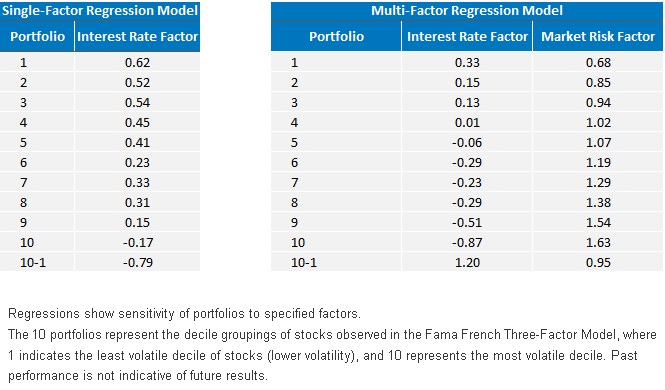Does A Minimum-Volatility Approach Compound Risk in Conservative Allocations?


I recently had a conversation with an asset allocation group that was building portfolios for a conservative clientele, typically with a 75%–80% fixed income allocation to emphasize only small tolerance for risk. This group was looking at the investment factor world and the widespread trends toward investment strategies oriented to minimum volatility (“min vol”). They thought this type of min-vol approach would be a good fit for their clientele.
At a surface level, I understand the intuitive appeal: minimum-volatility strategies ostensibly sound great for conservative portfolios. I noted, however, that min-vol strategies are likely to compound and concentrate the “bond duration” risk already loaded in their portfolios and thus actually serve as a poor diversifier for the 75% of the portfolio in fixed income strategies.
Min Vol Adding to Bond Risk?
In late September, I wrote a series of blog posts discussing the factors that I thought were contributing to the trends in low-volatility strategies—that is, the declining interest rate environment. The Utilities sector was a classic sector represented in low-volatility strategies and benefited from a decline in interest rates in early 2016. That outperformance started to shift on July 8, when the 10-Year-Yield in the U.S. turned around.
Those blog posts with evidence across a few sectors and major markets in 2016 generated some good discussions with clients, and one astute CIO forwarded me a recently released academic paper entitled “Does Interest Rate Exposure Explain the Low Volatility Anomaly?”1 The authors summarized their findings as follows:
We show that part of the outperformance of low volatility stocks can be explained by a premium for interest rate exposure. Low volatility portfolios have a negative exposure to interest rates, whereas the more volatile stocks have a positive exposure…. Our results […] imply a strong implicit exposure to interest rate risk of low volatility portfolios.
The regression models below illustrate the embedded interest rate factor exposure inherent to 10 different portfolios, sorted by their low-volatility characteristics. These volatility deciles, or portfolios, were taken from the Fama-French website and examined for their exposure to a specific interest rate factor. There were two sets of regressions shown here—one looking at each portfolio’s exposure to just this interest rate factor, and the other using a two-factor model incorporating market risk along with the interest rate factor.
Low-Volatility Embedded Interest Rate Exposure

For more information, see the Fama French website.
What is Embedded Bond Risk?
Using this two-factor approach, one might interpret the results as saying the lowest-volatility portfolio was allocating 33% to the interest rate factor (with a lower market beta of approximately .68), while the highest-volatility decile was like being short the interest rate factor (while also having a high market beta of 1.6).
This embedded “bond bet,” or bond exposure, inherent to a low-volatility approach perhaps suggests that investors who already have significant fixed income allocations should explore equity strategies that are less sensitive to interest rates.
It has been a long time since there was a bear market in bonds—and we do not expect any significant rise in rates that could cause a huge amount of pressure in this segment of the portfolio in the near term. But investors should be cognizant of the bond duration in their equity portfolios and perhaps look for diversifying strategies.
Within the equity income portion of an allocation, we suggest looking at our Quality Dividend Growth family of Indexes. These Indexes screen for factors that provide a forwarding-looking dividend growth profile, and the screens we utilize tend to be under-weight sectors with just the highest dividend yields—sectors such as Utilities, Telecommunications and REITs. We also believe this segment of the market is one of most attractively valued today.
1Joost Driessen, Ivo Kuiper, Robbert Beilo, “Does Interest Rate Exposure Explain the Low Volatility Anomaly?” SSRN, 10/9/16.
Important Risks Related to this Article
Dividends are not guaranteed, and a company currently paying dividends may cease paying dividends at any time.
Jeremy Schwartz has served as our Global Chief Investment Officer since November 2021 and leads WisdomTree’s investment strategy team in the construction of WisdomTree’s equity Indexes, quantitative active strategies and multi-asset Model Portfolios. Jeremy joined WisdomTree in May 2005 as a Senior Analyst, adding Deputy Director of Research to his responsibilities in February 2007. He served as Director of Research from October 2008 to October 2018 and as Global Head of Research from November 2018 to November 2021. Before joining WisdomTree, he was a head research assistant for Professor Jeremy Siegel and, in 2022, became his co-author on the sixth edition of the book Stocks for the Long Run. Jeremy is also co-author of the Financial Analysts Journal paper “What Happened to the Original Stocks in the S&P 500?” He received his B.S. in economics from The Wharton School of the University of Pennsylvania and hosts the Wharton Business Radio program Behind the Markets on SiriusXM 132. Jeremy is a member of the CFA Society of Philadelphia.

